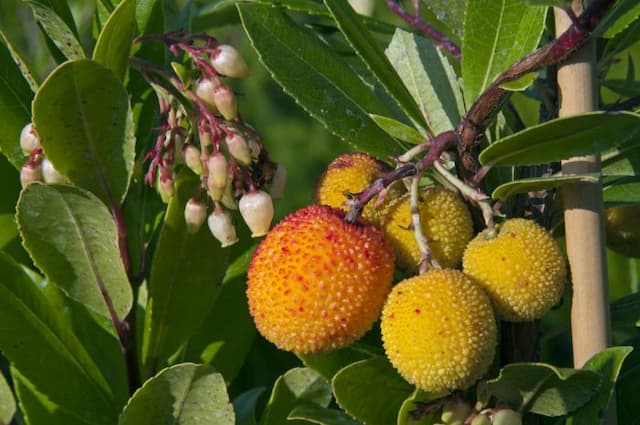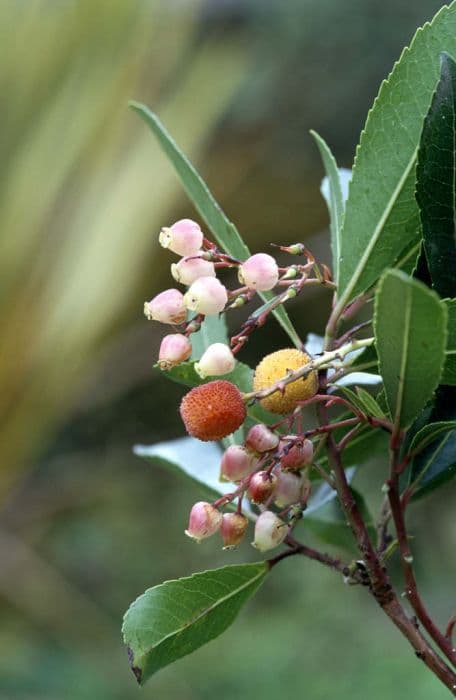Rhododendron Rhododendron 'Lord Roberts'

ABOUT
Rhododendron 'Lord Roberts' is a striking plant prized for its large, vibrant flowers. The blossoms are a rich crimson color, often showcasing a darker, almost blackish-red blotch on their upper lobes, which provides a dramatic contrast against the brighter red petals. These flowers appear in trusses, creating a bold and showy display that can be quite eye-catching in the landscape. The leaves of 'Lord Roberts' are leathery and dark green, with a glossy finish that complements the radiant flowers. They are elongated and oblong-shaped, with a smooth texture and edges that have a slight curl inward, giving the foliage a somewhat ruffled look. This plant's overall shape is bushy and well-branched, providing a lush backdrop to the spectacular floral arrangement. It tends to have a symmetrical habit with the leaves densely packed along the branches, creating a full and healthy appearance. The Rhododendron 'Lord Roberts', with its bright flowers, dark foliage, and bushy form, is a popular choice for adding a touch of elegance and drama to gardens. Its striking appearance often makes it a focal point wherever it is planted.
About this plant
 Names
NamesSynonyms
Lord Roberts Rhododendron, Lord Roberts Azalea
Common names
Rhododendron 'Lord Roberts'
 Toxicity
ToxicityTo humans
The Rhododendron, including the 'Lord Roberts' variety, contains toxic compounds which can be harmful if ingested. All parts of the plant, such as leaves, flowers, and nectar, contain substances known as grayanotoxins. If a person ingests part of the Rhododendron, symptoms of poisoning can include vomiting, diarrhea, drooling, weakness, hypotension, and in severe cases, can progress to coma, decreased cardiac function, and potentially death. Medical attention should be sought immediately if ingestion is suspected.
To pets
Rhododendron is toxic to pets, including the 'Lord Roberts' variety. Much like in humans, all parts of the plant contain grayanotoxins. If pets consume any part of the Rhododendron, they may exhibit symptoms such as vomiting, diarrhea, hypersalivation, weakness, incoordination, and in severe cases, cardiac problems can arise. In extreme instances, consumption can be fatal. Prompt veterinary care is necessary if a pet is suspected of ingesting any part of the Rhododendron.
 Characteristics
CharacteristicsLife cycle
Perennials
Foliage type
Evergreen
Color of leaves
Green
Flower color
Red
Height
6 feet (1.8 meters)
Spread
6 feet (1.8 meters)
Plant type
Shrub
Hardiness zones
7
Native area
Asia
Benefits
 General Benefits
General Benefits- Attractive Flowers: Rhododendron 'Lord Roberts' produces large, showy flowers that enhance the aesthetic appeal of gardens and landscapes.
- Pollinator Friendly: Its blooms attract bees, butterflies, and other pollinating insects, supporting local ecosystems.
- Privacy Screen: When planted in groups, they can form dense screens or hedges, providing privacy and reducing noise pollution.
- Shade Tolerance: This variety of rhododendron can thrive in partial shade, making it suitable for woodland gardens or shaded areas.
- Erosion Control: The plant's root system helps stabilize soil on slopes, reducing the risk of erosion.
- Seasonal Interest: It offers spring interest with its flowers and evergreen leaves provide year-round color and structure.
- Easy Pruning: Rhododendron 'Lord Roberts' generally requires minimal pruning, making it low maintenance for gardeners.
- Drought Resistance: Once established, some varieties of rhododendron can tolerate periods of dry weather.
 Medical Properties
Medical PropertiesThis plant is not used for medical purposes.
 Air-purifying Qualities
Air-purifying QualitiesThis plant is not specifically known for air purifying qualities.
 Other Uses
Other Uses- Rhododendron leaves can be used as a natural dye, particularly for wool, producing colors ranging from yellow to olive green depending on the mordant used.
- The plant's wood is sometimes carved into small decorative items or used in intarsia and marquetry due to its interesting grain and color.
- Rhododendrons can be utilized in garden design to create structured landscapes, leveraging their size and evergreen nature for hedges or privacy screens.
- The thick, leathery leaves of the Rhododendron are sometimes used as makeshift cups or wrappers for food during outdoor activities or in survival situations.
- Due to their dense growth, Rhododendron bushes can provide protective cover for ground-nesting birds and small mammals.
- The plant's tendency to grow in acidic soils means that they can be strategically planted to manage and indicate soil pH levels in gardens or reclamation sites.
- Dried Rhododendron petals, though not traditionally used, can be crafted into potpourris or sachets, providing a subtle floral fragrance.
- Rhododendron flowers can serve as a natural indicator of the onset of spring, as they typically bloom early in the season.
- Artists and photographers often use Rhododendron plants as a backdrop or a focus for natural art, due to their vibrant colors and large clusters of blooms.
- In some cultures, the blossoms of the Rhododendron are used in festive decorations during celebrations or as adornments in ceremonies.
Interesting Facts
 Feng Shui
Feng ShuiThe Rhododendron is not used in Feng Shui practice.
 Zodiac Sign Compitability
Zodiac Sign CompitabilityThe Rhododendron is not used in astrology practice.
 Plant Symbolism
Plant Symbolism- Beware: Rhododendrons, in general, are known to have toxic leaves and sometimes even honey made from their nectar can be poisonous, symbolizing caution or a warning.
- Elegance: The Rhododendron 'Lord Roberts' features beautiful blossoms that can represent elegance or sophistication due to their visual appeal.
- Abundance: With the Rhododendron 'Lord Roberts' often producing an abundance of flowers, it can symbolize both abundance and bloom or growth.
- Warning: Similar to 'beware', the Rhododendron signifies a warning, reminding one to be cautious about things that appear beautiful but may hide danger.
- Survival: Rhododendrons are hardy plants that can survive in challenging environments, symbolizing endurance and the ability to thrive despite difficulties.
 Water
WaterRhododendrons, including 'Lord Roberts', typically require consistent moisture. They should be watered deeply once a week to ensure that the soil is moist but not saturated. During dry spells or in particularly hot climates, watering may need to increase to twice a week. Use about 1 gallon of water per foot of plant height each time you water, ensuring it reaches the plant's deep roots. Avoid overhead watering to prevent disease, and provide enough water to keep the soil evenly moist, especially during the growing season.
 Light
LightRhododendrons like 'Lord Roberts' thrive in dappled shade. It is best to position the plant where it can receive morning sunlight and afternoon shade to protect it from harsh midday sun. They do well in spots that are shielded by taller trees or structures that provide partial sunlight, as full sun can lead to leaf scorch.
 Temperature
TemperatureRhododendrons such as 'Lord Roberts' do well in temperate climates and prefer a temperature range between 40°F and 75°F. They can tolerate a brief dip below freezing, but prolonged exposure to temperatures below 20°F can cause damage to the plant. The ideal growth conditions for rhododendrons are cool to moderate temperatures without extreme fluctuations.
 Pruning
PruningPrune 'Lord Roberts' rhododendrons to maintain shape, remove dead or diseased wood, and promote vigorous growth. The best time for pruning is immediately after the plant finishes blooming in late spring. You can prune annually, thinning out the interior branches to improve air circulation and light penetration within the plant. Removing faded flowers can also encourage bushier growth and more flowers in the subsequent year.
 Cleaning
CleaningAs needed
 Soil
SoilRhododendrons require acidic, well-draining soil with a pH of 4.5 to 6.0. A soil mix for Lord Roberts, a type of Rhododendron, can be made with equal parts peat moss, pine bark, and perlite to ensure proper drainage and acidity.
 Repotting
RepottingRhododendrons, including 'Lord Roberts', should be repotted every 2 to 3 years when the plant is young, and less frequently as it matures, or when it is visibly outgrown its current pot.
 Humidity & Misting
Humidity & MistingRhododendrons thrive in moderate to high humidity levels; 'Lord Roberts' does well with humidity levels around 40-60%.
 Suitable locations
Suitable locationsIndoor
Place 'Lord Roberts' in bright, indirect light; keep soil moist.
Outdoor
Plant in dappled shade, protect from wind, mulch root zone.
Hardiness zone
5-8 USDA
 Life cycle
Life cycleRhododendron 'Lord Roberts' starts its life cycle when the seeds are dispersed, generally by wind, and land in moist, well-draining acidic soil with partial to full shade. Upon germination, seedlings establish themselves with small root systems and start to produce the characteristic leathery leaves. As the plant matures into a shrub, it undergoes vegetative growth, increasing in size and producing evergreen foliage that persists throughout the year. During the spring, 'Lord Roberts' reaches the flowering stage, showcasing clusters of large, bell-shaped flowers that are typically purple or violet with spotted throat markings – attracting pollinators like bees and butterflies. After pollination, the flowers develop into dry seed capsules that release seeds, completing the reproductive cycle. The plant maintains a perennial cycle, with individual specimens living for many years, continually growing and producing flowers annually.
 Propogation
PropogationPropogation time
Late winter to early spring
Rhododendron 'Lord Roberts', commonly known as a kind of rhododendron, is propagated primarily through semi-hardwood cuttings. The best time to take cuttings is late summer to early fall, ensuring that the plant has begun to harden off but is not yet fully dormant. The process involves selecting healthy, disease-free shoots that have matured after the spring growth flush. Cuttings should be about 4 to 6 inches (10 to 15 centimeters) long, with leaves removed from the lower half. The cut end is often treated with a rooting hormone to enhance root development and then inserted into a pot filled with a mixture of peat and perlite or a similar well-draining rooting medium. The cuttings require consistent warmth, high humidity, and indirect light to root successfully, which generally takes several weeks to a few months. After rooting, the new rhododendron plants can be gradually acclimated to outdoor conditions before planting in their final location.









